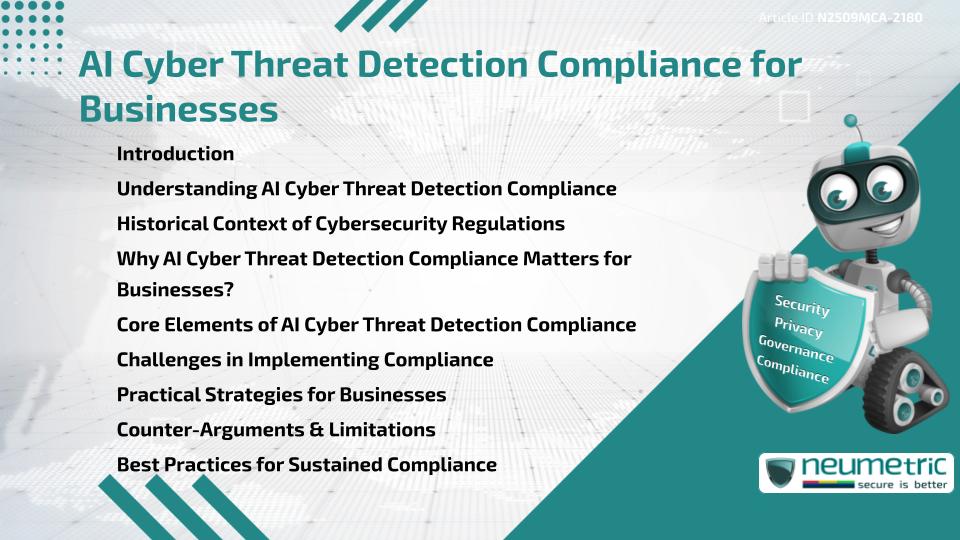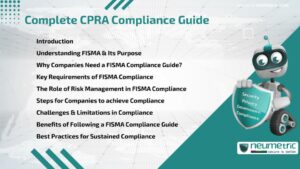Table of Contents
ToggleIntroduction
As cyberattacks grow in scale & sophistication, Artificial Intelligence is increasingly used to defend against them. Yet AI itself introduces Risks that require structured oversight. AI Cyber Threat detection compliance ensures that businesses deploy AI responsibly when monitoring, detecting & responding to security Threats. These regulations guide Organisations in aligning their Security Measures with national & international laws, ethical expectations & Industry Standards. Businesses that understand & follow these frameworks not only protect Sensitive Data but also build trust with regulators, customers & partners.
Understanding AI Cyber Threat Detection Compliance
AI Cyber Threat detection compliance refers to the regulatory & procedural requirements that govern how businesses use AI to detect malicious activity. Unlike traditional Security Measures, AI-driven detection tools analyze vast amounts of data in real time, learning to identify suspicious patterns. Compliance ensures these tools operate within legal & ethical boundaries, balancing effective security with Privacy protections.
For instance, the NIST Cybersecurity Framework & the European Union Cybersecurity Act set guidelines for responsible AI usage. These frameworks encourage transparency, accountability & standardised processes across industries.
Historical Context of Cybersecurity Regulations
Cybersecurity compliance is not new. Early frameworks such as the ISO/IEC 27001 Standard & laws like the Sarbanes-Oxley Act laid the foundation for structured incident management & reporting. As AI emerged, regulators recognized its potential to both strengthen & complicate Cybersecurity. This led to AI-specific considerations, such as explainability in automated Threat detection & the ethical use of monitoring data. Today, AI Cyber Threat detection compliance extends earlier principles to address challenges unique to AI-powered security.
Why AI Cyber Threat Detection Compliance Matters for Businesses?
AI Systems can enhance Cybersecurity by quickly spotting anomalies & reducing response times. However, if these systems are poorly designed or misused, they can lead to false positives, overlooked Threats or even Privacy violations. AI Cyber Threat detection compliance helps businesses mitigate these Risks by enforcing standards for data handling, accuracy & accountability.
Compliance also carries business advantages. Regulators increasingly scrutinize AI-driven Cybersecurity solutions & non-compliance can lead to penalties, litigation & reputational damage. On the other hand, Organisations that demonstrate compliance gain a competitive edge, as customers prefer to work with businesses that protect data responsibly.
Core Elements of AI Cyber Threat Detection Compliance
Several key elements define AI Cyber Threat detection compliance frameworks:
- Risk Assessment: Regularly evaluating AI Models for Vulnerabilities & bias.
- Transparency: Ensuring that AI-driven Systems provide explanations for decisions.
- Data Governance: Protecting Sensitive Data used in training & monitoring.
- Incident reporting: Following consistent procedures for notifying regulators & Stakeholders.
- Auditability: Maintaining logs & documentation for external review.
Together, these components ensure that AI-powered security solutions are effective, fair & accountable.
Challenges in Implementing Compliance
Despite its benefits, AI Cyber Threat detection compliance presents challenges for businesses:
- Complexity of AI Models: Many AI Systems act as “black boxes,” making it hard to explain decisions.
- Regulatory fragmentation: Laws vary by country & industry, complicating global compliance.
- High costs: Smaller businesses may lack the resources to implement full compliance measures.
- Evolving Threats: Cybercriminals constantly adapt, forcing compliance frameworks to evolve too.
These hurdles mean businesses must treat compliance as an ongoing process rather than a one-time exercise.
Practical Strategies for Businesses
Businesses can take concrete steps to strengthen AI Cyber Threat detection compliance:
- Develop internal Policies that align with external regulations.
- Train Employees to understand AI-driven detection & reporting processes.
- Use explainable AI tools to increase transparency & trust.
- Partner with external Auditors to evaluate compliance gaps.
- Simulate Threat detection scenarios to test response readiness.
These strategies create a culture of proactive compliance & resilience against cyber Risks.
Counter-Arguments & Limitations
Some argue that strict AI Cyber Threat detection compliance could stifle innovation, especially for startups. Others believe existing frameworks are too rigid, failing to keep pace with rapidly evolving Cyber Threats. Additionally, critics warn that compliance may prioritise regulatory checkboxes over actual security effectiveness.
Nevertheless, the absence of compliance poses greater dangers. Without structured oversight, businesses Risk unchecked AI usage, leading to Privacy violations, legal liabilities & weakened Customer Trust.
Best Practices for Sustained Compliance
To sustain compliance long term, businesses should:
- Regularly update Security Policies & AI Models.
- Engage with regulators & industry bodies to stay informed.
- Incorporate ethical principles into AI System design.
- Maintain clear communication with Stakeholders about compliance efforts.
- Treat compliance as part of the broader business strategy, not just a technical task.
These Best Practices help Organisations move beyond meeting minimum requirements to building trust & resilience.
Takeaways
AI Cyber Threat detection compliance is essential for protecting businesses in a world of growing cyber Risks. While it presents challenges, businesses that embrace compliance frameworks not only safeguard data but also strengthen their reputation & competitive advantage.
FAQ
What is AI Cyber Threat detection compliance?
It is the set of regulations & procedures that govern how businesses use AI to detect & manage Cybersecurity Threats.
How does AI Cyber Threat detection compliance differ from general Cybersecurity rules?
It focuses specifically on AI-driven Systems, addressing challenges like transparency, explainability & ethical use of data.
Why should businesses invest in AI Cyber Threat detection compliance?
Compliance reduces Risks of legal penalties, protects Sensitive Data & builds Customer Trust.
Which laws & standards apply to AI Cyber Threat detection compliance?
Key examples include the NIST Cybersecurity Framework, ISO/IEC 27001 & the EU Cybersecurity Act.
What challenges do Small Businesses face with AI Cyber Threat detection compliance?
They often struggle with limited budgets, technical expertise & adapting to varying regulations across regions.
Can compliance improve a company’s reputation?
Yes, demonstrating strong compliance signals accountability & attracts customers who value Data Protection.
Does AI Cyber Threat detection compliance prevent all cyberattacks?
No, compliance reduces Risks but cannot guarantee total prevention. It must be combined with ongoing monitoring & adaptation.
Need help for Security, Privacy, Governance & VAPT?
Neumetric provides organisations the necessary help to achieve their Cybersecurity, Compliance, Governance, Privacy, Certifications & Pentesting needs.
Organisations & Businesses, specifically those which provide SaaS & AI Solutions in the Fintech, BFSI & other regulated sectors, usually need a Cybersecurity Partner for meeting & maintaining the ongoing Security & Privacy needs & requirements of their Enterprise Clients & Privacy conscious Customers.
SOC 2, ISO 27001, ISO 42001, NIST, HIPAA, HECVAT, EU GDPR are some of the Frameworks that are served by Fusion – a SaaS, multimodular, multitenant, centralised, automated, Cybersecurity & Compliance Management system.
Neumetric also provides Expert Services for technical security which covers VAPT for Web Applications, APIs, iOS & Android Mobile Apps, Security Testing for AWS & other Cloud Environments & Cloud Infrastructure & other similar scopes.
Reach out to us by Email or filling out the Contact Form…





